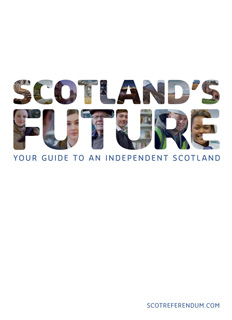 Scotland’s Future is a Scottish Government white paper published on 26 November 2013. It lays out the case for Scottish independence and the means through which Scotland would become an independent country in personal union with the United Kingdom. It was described as the “most comprehensive blueprint for an independent country ever published”, and argued it sought independence not “as an end in itself, but rather as a means to changing Scotland for the better”.
Scotland’s Future is a Scottish Government white paper published on 26 November 2013. It lays out the case for Scottish independence and the means through which Scotland would become an independent country in personal union with the United Kingdom. It was described as the “most comprehensive blueprint for an independent country ever published”, and argued it sought independence not “as an end in itself, but rather as a means to changing Scotland for the better”.
Produced in a very tight timescale, it comprehensively covered in 670 pages:
- Independence
- Public finances
- Finance and the economy
- Health, wellbeing and social protection
- Education, skills and employment
- International relations and defence
- Justice, security and home affairs
- Environment, rural Scotland, energy and resources
- Culture, communications and digital
- Building a modern democracy
As a manifesto, it can be compared to the EU referendum, where an 8 page document resulted in a debate which seldom rose above the level of platitudes and soundbites – meaningful ones (like £350 million for the NHS) being recanted after the result, and meaningless ones such as “take back control” re-interpreted.
It has been argued that next time, we should go with much less detail, following the EU example of treating the electorate as mushrooms – to be kept in the dark and fed bullshit! That would be irresponsible.
A great deal has happened since 2014, generally to make the independence case stronger:
- The democratic deficit of Scotland within the Union has grown – Evel, another Tory government we didn’t vote for, Remain vote ignored, Sewel and Barnett undermined
- The economic certainty of staying in a Brexit UK has diminished – the status quo has vanished
- The certainty of remaining in Europe (EU or EFTA) has reversed
- The opportunities of remaining in Europe (EU or EFTA) while the UK exits have increased
- The acceptability of an independent Scotland in Europe (EU or EFTA) has increased
- It has been clarified that an independent Scotland would not have to use the euro or queue to join
- On currency, the pound has been devalued by 20%, and is no longer necessarily the best option
- The powers devolved to Scotland have been minor, grudging and booby-trapped
- The price of oil has halved and oil revenues disappeared, yet the Scottish economy has survived
Several things could be improved next time:
- We should admit that transition will not be simple, cheap, fast or risk-free
- We should accept that UK reaction will be hostile, and have contingency plans defined
- We should highlight where an independent Scotland will do things differently
Scotland’s referendum on 18 September 2014 was a choice between two futures. A Yes vote was to ensure the most important decisions about our economy and society would be taken by the people who care most about Scotland, that is by the people of Scotland. A No vote, to ensure Scotland stood still, is no longer an option. We can make Scotland’s vast wealth and resources work much better for everyone in our country, creating a society that reflects our hopes and ambition. Being independent means we will have a government that we choose – a government that always puts the people of Scotland first.
Scotland’s future will be in Scotland’s hands.
You can download the 2014 Referendum ‘Scotland’s Future’ as a pdf or an ebook. Yes Edinburgh West has a website, Facebook, Twitter, National Yes Registry and a Library of topics on Scottish Politics, including Independence.
